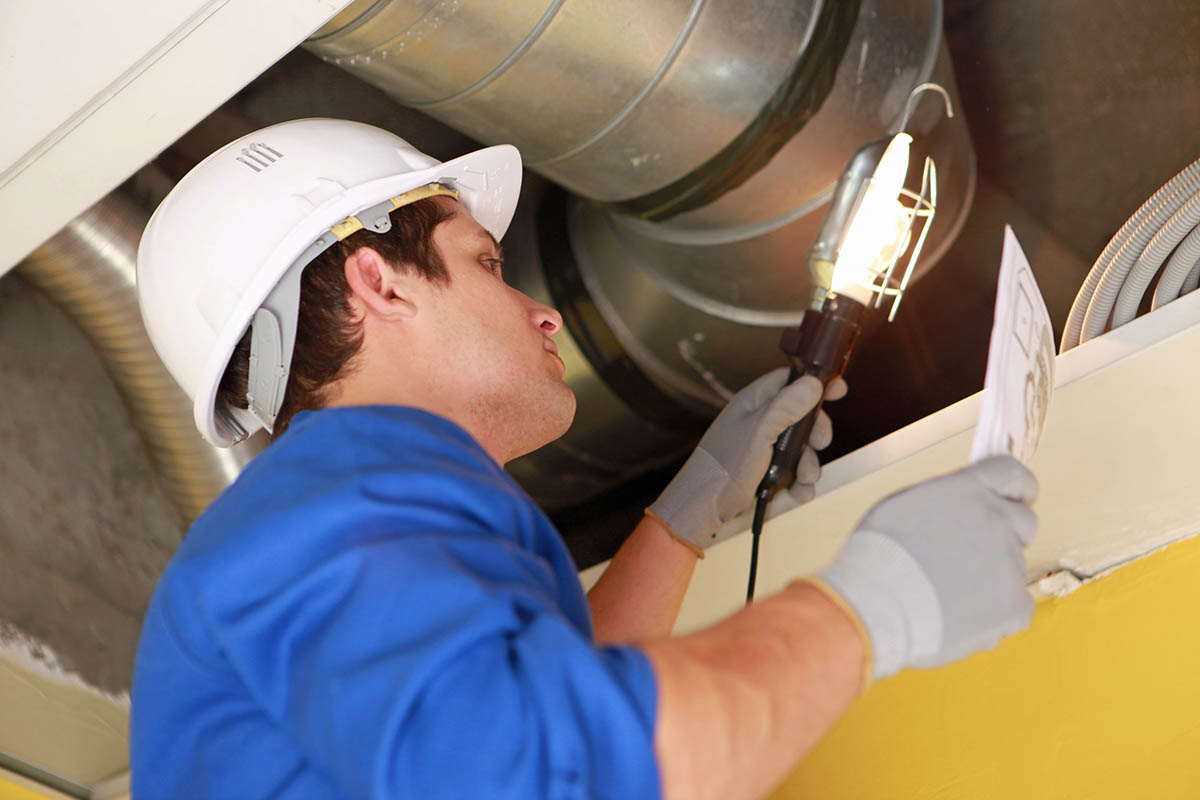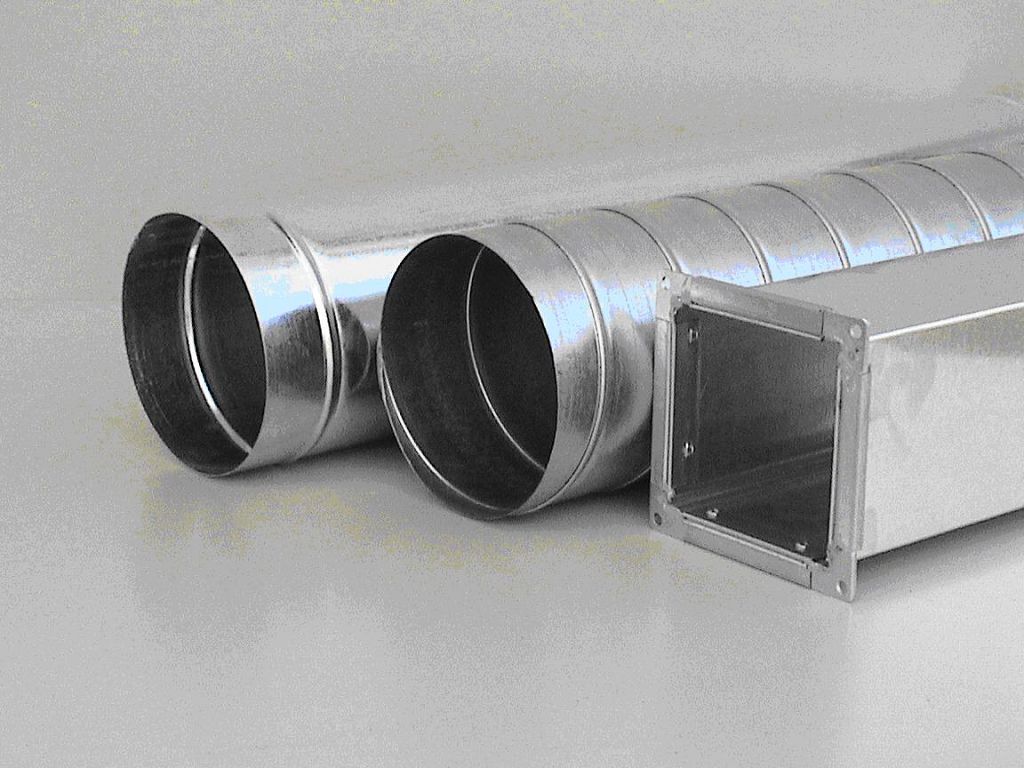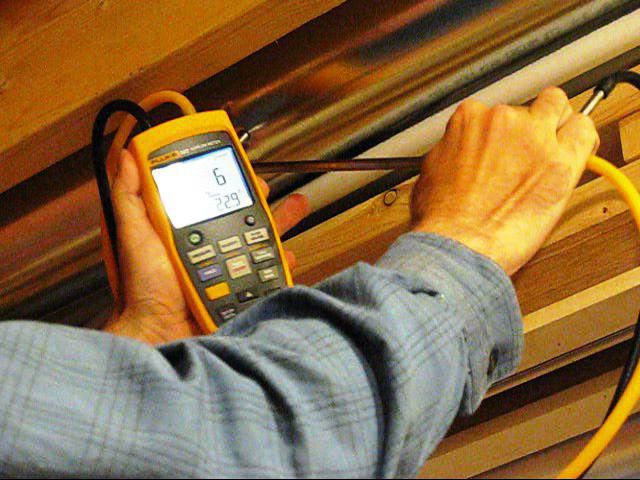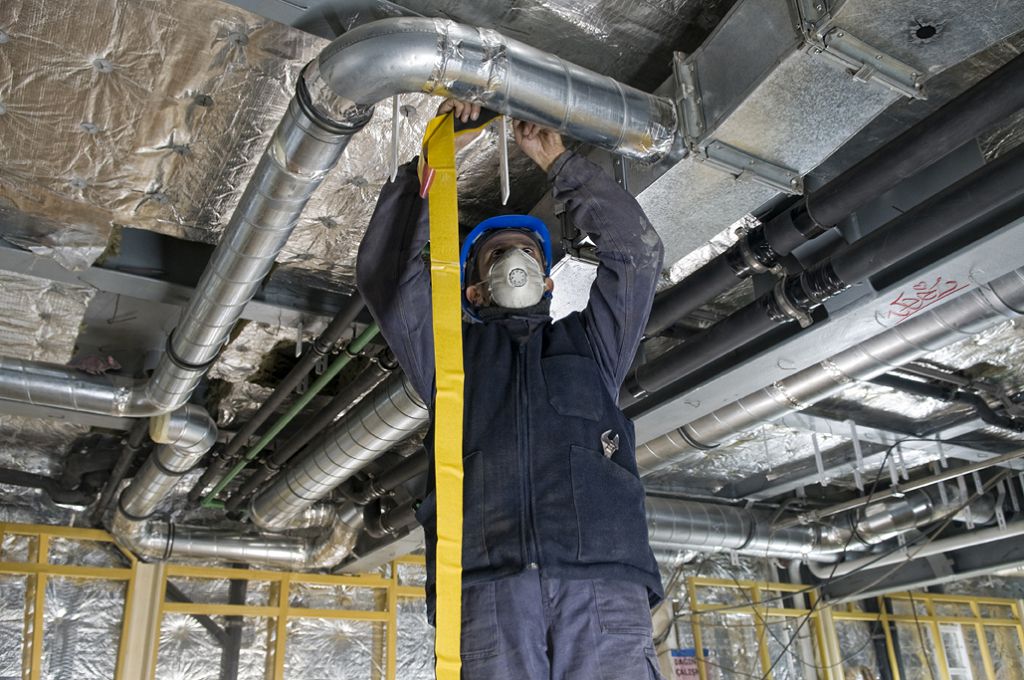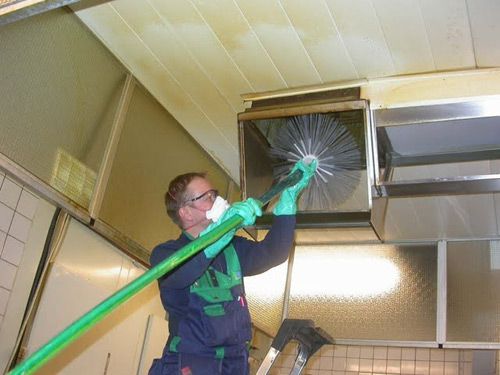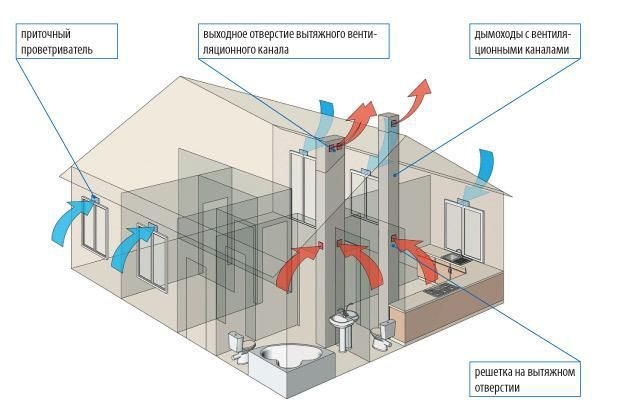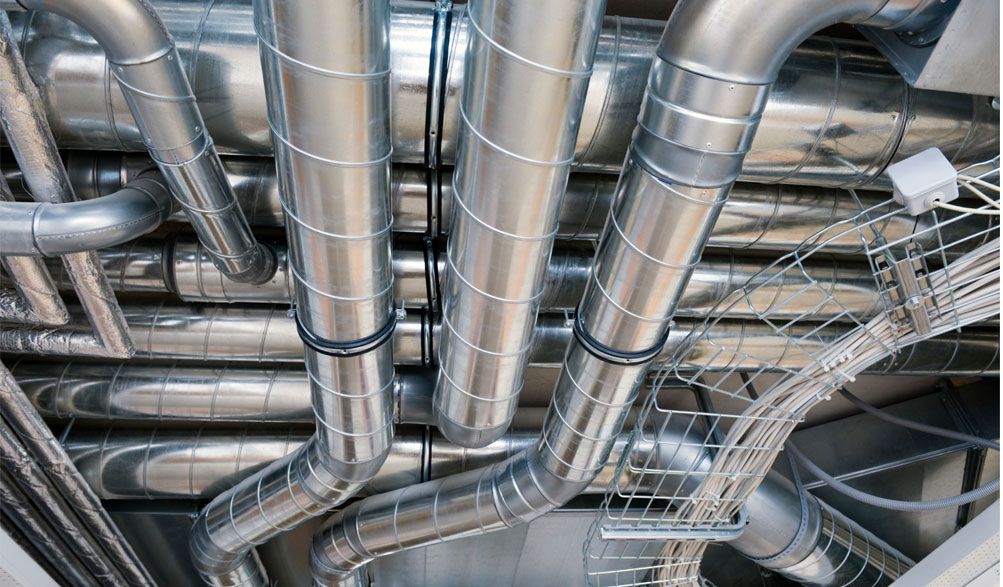Today in modern construction there are branches in which research is carried out to improve the technology of construction, also improve the quality during operation, the air exchange of premises in the building is no exception. Problems in this area are relevant and are solved by selecting the multiplicity for the ventilation system. Full-scale tests are carried out and standards are written on the basis of them. The most successful country in this matter is the United States. They developed the ASHRAE standard, using the experience of other countries, namely Germany, Denmark, Finland, and their scientific developments. In the post-Soviet space, there is also a developed analogue of such a document. In 2002, AVOK developed standards for "air exchange rates for public and residential buildings."
The construction of modern structures is carried out with the expectation of increased insulation and high tightness of windows. Therefore, optimal air exchange is very important in such cases in order to comply with sanitary and hygienic standards and an appropriate microclimate. It is also important not to damage energy saving, so that in winter all the heat is not drawn into the ventilation, and cool air from the air conditioner in summer.
To determine the calculation of air exchange in rooms other than hospitals, a new method was created and described in ASHRAE publication 62–1–2004. It is determined by summing the values \ u200b \ u200bof the value of fresh outdoor air, which is supplied directly for breathing, taking into account the area of \ u200b \ u200bthe room falling on one person. As a result, the value turned out to be significantly lower than the later edition of ASHRAE.
Air exchange rates in residential buildings
When carrying out the calculation, it is necessary to use the data in the table, provided that the saturation level of harmful components is not higher than the MPC standards.
| Premises | Air exchange rate | Notes (edit) |
| Living sector | Frequency rate 0.35 h-1, but not less than 30 m³ / h * pers. | When calculating (m3/ h) by the multiplicity of the volume of the room, the area of the room is taken into account |
| 3 m³ / m² * h of residential premises, with an apartment area of less than 20 m² / person. | Rooms with air-enclosing structures require additional hoods | |
| Kitchen | 60 m³ / h for electric cooker | Air supply to living rooms |
| 90 m³ / h for using a 4-burner gas hob | ||
| Bathroom, toilet | 25 m³ / h from each room | Same |
| 50 m³ / h with a combined bathroom | ||
| Laundry | Multiplicity 5 h-1 | Same |
| Dressing room, pantry | Multiplicity 1 h-1 | Same |
In cases of non-use of premises for housing, the indicators are reduced in this way:
- in the living area for 0.2h-1;
- in the rest: kitchen, bathroom, toilet, pantry, wardrobe for 0.5h-1.
At the same time, it is necessary to avoid the ingress of running air from these premises into the living quarters, if it is present there.
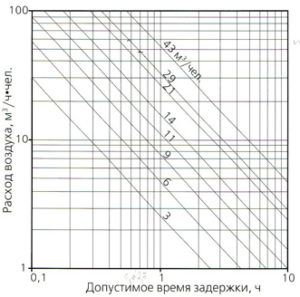
In cases where the air entering the room from the street travels a long distance to the hood, the rate of air exchange also increases. There is also such a thing as delayed ventilation, which implies a lag in the ingress of oxygen from the outside before the start of its use in the room. This time is determined using a special diagram (see figure 1), taking into account the lowest air exchange rates in the above table.
For instance:
- air consumption 60 m³ / h * person;
- housing volume 30 m³ / person;
- lag time 0.6 h.
Air exchange rates for office buildings
Norms in such buildings will be much higher, because ventilation must effectively cope with the large amount of carbon dioxide emitted by office employees and equipment located there, remove excess heat, while supplying clean air. In this case, natural ventilation will not be enough; the use of such a system today cannot provide the required hygienic and air exchange standards. During construction, hermetically closed doors and windows are used, and the panoramic glazing device completely restricts the ingress of air from the outside, which leads to stagnation of air and a deterioration in the microclimate of housing and the general condition of a person. Therefore, it is necessary to design and install special ventilation.
The main requirements for such ventilation include:
- the ability to provide a sufficient volume of fresh clean air;
- filtration and elimination of used air;
- no exceeding of noise standards;
- convenient control;
- low energy consumption;
- the ability to fit into the interior and be small in size.
In conference rooms, additional air inlets must be installed, and hoods must be installed in toilets, corridors and copy rooms. In offices, a mechanical hood is installed in cases where the area of each office exceeds 35 sq. m.
As practice shows, in case of incorrect distribution of a large air flow in offices with low ceilings, a feeling of draft is created, and in this case people demand to turn off the ventilation.
Organization of air exchange in a private house
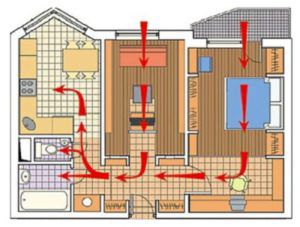
A healthy microclimate and well-being depend largely on the correct organization of the supply and exhaust system in the house. Often during the design, ventilation is forgotten or paid little attention, thinking that one hood in the toilet will be enough for this. And often the air exchange is organized incorrectly, which leads to many problems and is fraught with a threat to human health.
In the case when there is insufficient outlet of polluted air, then the room will have a high level of humidity, the possibility of infection of the walls with fungus, fogging of the windows and a feeling of dampness. And when there is a bad flow, there is a lack of oxygen, a lot of dust and high humidity or dryness, it depends on the season outside the window.
Properly arranged ventilation and air exchange in the house looks as shown in the figure.
The air entering the dwelling must first pass through the window or open sash of the window, the supply valve is located on the outside of the wall of the dwelling, then, passing through the room, it penetrates under the door leaf or through special ventilation holes and enters the bathrooms and the kitchen. Longer comes out through the hood system.
The way of organizing the exchange of air differs in the use of ventilation systems: mechanical or natural, but in all cases, the air is supplied from residential areas, and goes into technical areas: a bathroom, a kitchen and others. When using any system, it is imperative to arrange ventilation ducts in the inner part of the main wall, this will avoid the so-called overturning of the air flow, which means its reverse movement before as shown in Figure 2. Through these ducts, the exhaust air is discharged outside.
What is air exchange for?

Air exchange is the flow rate of the supplied outdoor air, m3 / h, that enters the building through the ventilation system (Figure 3). Environmental pollution in living rooms comes from sources located in them - it can be furniture, various fabrics, consumer products and human life, household products.This also happens by gas formation from the effects of the exhalation of carbon dioxide by a person and other vital processes of the body, various technical vapors that can be present in the kitchen from the combustion of gas on the stove and many other factors. Therefore, air exchange is so necessary.
To maintain normal air readings in the home, the CO2 saturation should be monitored by adjusting the ventilation system based on concentration. But there is a second method, the more common one - this is a method of controlling air exchange. It is much cheaper and in many cases more efficient. There is a simplified way to estimate it using Table 2.
| Class by GOST | Air quality characteristics | Incoming air consumption per person, m3/ (hour * people) |
| IDA1 | High | > 54 (value in par 72) |
| IDA2 | Average | 36-54 (value in nominal 45) |
| IDA3 | Acceptable | 22-36 (value in nominal 29) |
| IDA4 | Low | <22 (nominal value 18) |
But when designing a mechanical ventilation system in a house or apartment, you need to make a calculation.
How to check if the ventilation is working?
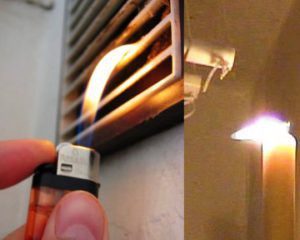
First, it is checked whether the hood is working, for this you need to bring a sheet of paper or a flame from a lighter directly to the ventilation grill located in the bathroom or kitchen. The flame or leaf should bend towards the hood, if this is the case, then it works, and if this does not happen, then the channel may be blocked, for example, clogged with leaves or for some other reason. Therefore, the main task is to eliminate the cause and provide traction in the channel.
In cases where the draft is unstable from the neighbors, the air flow can pass to you, while bringing in extraneous odors to your apartment, this is a sign of reverse draft. To eliminate it, it is necessary to mount special shutters that will close when a reverse draft appears.
Conclusion
When building your own home, be sure to pay the necessary attention to ventilation in the house or apartment. And invest the necessary amount in creating the correct hood that meets modern standards for air exchange, which will make it possible to get the most comfortable microclimate and eliminate the threat of various diseases to your health in the event of its incorrect installation.

